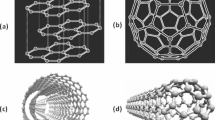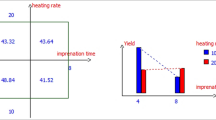Abstract
This work evaluated three activation methods, physical activation, chemical activation and combined physical–chemical activation, for preparing activated carbon (AC) from rock asphalt. A high carbon content and the low cost of rock asphalt makes it a good possible raw material for the preparation of activated carbon. The objective of this research was to establish what preparation conditions resulted in the AC with the best performance. Orthogonal experimental design was used to optimize preparation conditions. The criteria for evaluating the AC preparation methods were yield, surface area and mercury adsorption performance of the AC samples prepared with each technique. The optimum experimental conditions for AC preparation using the chemical activation method are: a carbonization heating rate of 12 °C min−1, a carbonization temperature of 400 °C, a carbonization time of 60 min, an activation temperature of 850 °C, an activation time of 120 min and a KOH/asphaltene mix rate of 3 (w/w). The potassium hydroxide added in the chemical activation method reduced the formation of volatiles during the carbonization process. The KOH/asphaltene mix rate and the carbonization temperature play a decisive role on the specific surface area and Hg adsorption capacity of AC. The optimum experimental conditions for AC preparation using the combined physical–chemical activation method are: a carbonization temperature of 450 °C, a carbonization time of 40 min, an activation temperature of 800 °C, an activation time of 60 min, a KOH/asphaltene mix rate of 1 and a steam flow rate of 8 g h−1. In the combined physical–chemical activation method, the KOH/C mix rate, activation temperature and steam flow rate are the primary factors affecting the surface area and Hg adsorption capacity. The surface areas of the AC samples prepared under the optimum experimental conditions in the chemical activation method and the combined physical–chemical activation methods were 2834.3 m2 g−1 and 2102.2 m2 g−1, respectively. The physical activation method was not suitable for preparing AC from rock asphalt due to low char yields.









Similar content being viewed by others
References
Li S, Han K, Li J, et al. Preparation and characterization of super activated carbon produced from gulfweed by KOH activation. Microporous Mesoporous Mater. 2017;243:291–300.
Mohammad SG, Ahmed SM. Preparation of environmentally friendly activated carbon for removal of pesticide from aqueous media. Int J Ind Chem. 2017;8(2):121–32.
De M, Azargohar R, Dalai AK, et al. Mercury removal by bio-char based modified activated carbons. Fuel. 2013;103(103):570–8.
Valix M, Cheung WH, Mckay G. Preparation of activated carbon using low temperature carbonization and physical activation of high ash raw bagasse for acid dye adsorption. Chemosphere. 2004;56(5):493–501.
Wu M, Shi L, Mi J. Preparation and desulfurization kinetics of activated carbons from semi-coke of coal liquefaction residual. J Therm Anal Calorim. 2017;129(3):1–11.
Shi H, Xu T, Zhou P, et al. Combustion properties of saturates, aromatics, resins, and asphaltenes in asphalt binder. Constr Build Mater. 2017;136:515–23.
Xu T, Wang Y, Xia W, et al. Effects of flame retardants on thermal decomposition of SARA fractions separated from asphalt binder. Constr Build Mater. 2018;173:209–19.
Buckley J. Asphaltene deposition. Energy Fuels. 2012;26(7):4086–90.
Ariyadejwanich P, Tanthapanichakoon W, Nakagawa K, et al. Preparation and characterization of mesoporous activated carbon from waste tires. Carbon. 2003;41(02):157–64.
Yorgun S, Yıldız D. Preparation and characterization of activated carbons from Paulownia wood by chemical activation with H3PO4. J Taiwan Chem E. 2015;53:122–31.
Lozano-Castelló D, Lillo-Ródenas MA, Cazorla-Amorós D, et al. Preparation of activated carbons from Spanish anthracite—I. Activation by KOH. Carbon. 2001;39(5):741–9.
Virla LD, Montes V, Wu J, et al. Synthesis of porous carbon from petroleum coke using steam, potassium and sodium: combining treatments to create mesoporosity. Microporous Mesoporous Meter. 2016;234:239–47.
Han Z, Yao Q, Zhang Y, Du Z, Li F. Synthetic process optimization and thermal analysis of 1,1′-diamino-5,5′-azotetrazole. J Therm Anal Calorim. 2015;121(2):951–7.
Zou G, Xu J, Wu C. Evaluation of factors that affect rutting resistance of asphalt mixes by orthogonal experiment design. Int J Pavement Res Technol. 2017;10(3):282–8.
Balak Z, Zakeri M. Application of Taguchi L 32, orthogonal design to optimize flexural strength of ZrB2-based composites prepared by spark plasma sintering. Int J Refract Met Hard Mater. 2016;55:58–67.
Zhong L, Zhang Y, Ji Y, et al. Synthesis of activated carbon from coal pitch for mercury removal in coal-fired power plants. J Therm Anal Calorim. 2016;123(1):851–60.
Açıkyıldız M, Gürses A, Karaca S. Preparation and characterization of activated carbon from plant wastes with chemical activation. Microporous Mesoporous Mater. 2014;198(198):45–9.
Kwon SH, Lee E, Kim BS, et al. Preparation of activated carbon aerogel and its application to electrode material for electric double layer capacitor in organic electrolyte: effect of activation temperature. Korean J Chem Eng. 2015;32(2):248–54.
Rambabu N, Rao BVSK, Surisetty VR, et al. Production, characterization, and evaluation of activated carbons from de-oiled canola meal for environmental applications. Ind Crop Prod. 2015;65:572–81.
Lecea SMD, Almela-Alarcón M, Linares-Solano A. Calcium-catalysed carbon gasification in CO2, and steam. Fuel. 1990;69(1):21–7.
Lin HC, Hu J, Lee WJ, et al. Adsorption characteristics and pore structure of activated carbons prepared from sorghum distillery residue. J Fac Agric Kyushu Univ. 2015;60(1):173–82.
Cervantes-Gaxiola ME, Arroyo-Albiter M, Pérez-Larios A, et al. Experimental and theoretical study of NiMoW, NiMo, and NiW sulfide catalysts supported on an Al, Ti, Mg mixed oxide during the hydrodesulfurization of dibenzothiophene. Fuel. 2013;113(2):733–43.
Qiang Z, Gurkan B, Ma J, et al. Roll-to-roll fabrication of high surface area mesoporous carbon with process-tunable pore texture for optimization of adsorption capacity of bulky organic dyes. Microporous Mesoporous Mater. 2016;227:57–64.
Qiang Z, Liu X, Zou F, et al. Bimodal porous carbon-silica nanocomposites for Li-Ion batteries. J Phys Chem C. 2017;121(31):16702–9.
Acknowledgements
This work was supported by the National Key Research and Development Program of China (No. 2016YFB0600205), the National Natural Science Foundation of China (51706069) and the Fundamental Research Funds for the Central Universities (2017JQ002).
Author information
Authors and Affiliations
Corresponding author
Rights and permissions
About this article
Cite this article
Zhong, L., Zhang, Y., Wang, T. et al. Optimized methods for preparing activated carbon from rock asphalt using orthogonal experimental design. J Therm Anal Calorim 136, 1989–1999 (2019). https://doi.org/10.1007/s10973-018-7855-x
Received:
Accepted:
Published:
Issue Date:
DOI: https://doi.org/10.1007/s10973-018-7855-x




